Epoxy
April 14, 2021
RV Surge
“Unprecedented Demand”: RV Sales Hit Record In February, On Pace For Blowout 2021
by Tyler DurdenWednesday, Apr 14, 2021 – 11:05 AM
With median prices for both existing and new homes at all time highs, and soaring at a record annualized rate of almost 20%…

… increasingly more Americans find themselves priced out of homeownership and, unwilling to rent shoeboxes in those liberal bicoastal, record tax incubators, are instead opting to not purchase expensive (and stationary) homes altogether, and are picking a far cheaper (and mobile) option.
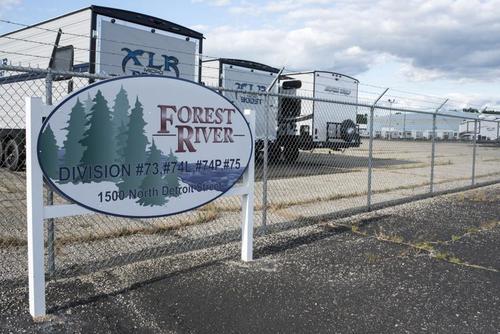
According to the RV Industry Association (RVIA), an industry association trade group that monitors the RV industry, manufacturers are shipping a record number of new units to dealer lots across the county that are being snapped up almost as soon as they arrive.
A February survey of manufacturers showed total RV shipments for the month topping out at 48,286 units, an increase of 30.1% compared to the same period last year, making February 2021 the best February on record.

“As people begin to think about their spring and summer vacations, RV trips continue to be the preferred way to travel for millions of Americans,” said RV Industry Association President & CEO Craig Kirby. “As evident in this month’s record shipment report, RV manufacturers and suppliers are committed to meeting the demand from new consumers as well as those looking to upgrade their existing RVs. According to the report, the industry remains on track to build more RVs in 2021 than in any previous year.”
It’s part of a continuing trend the RVIA has been watching closely: “We’re on quite a streak right now,” said Monika Geraci, a RVIA analyst and spokesperson. “November and December were record-breaking months, too.”
According to the recent study commissioned by RVIA, RV wholesale shipments appear to be headed to their highest levels in 2021. Those projections show total RV shipments ranging between 523,000 units and 543,000 units for the coming year, representing a 23% increase over the 2020 year-end total of 430,412 units. It suggests a 5% gain over the record high of 504,600 units shipped in 2017.
“RV shipments in 2021 are forecast to reach record highs as the industry continues its over 40 years of long-term growth,” said Kirby. “We expect consumers to continue to turn to RVs not only because they allow people to recreate responsibly, but also because RVs allow people the freedom to live a fun, active outdoor lifestyle.”
Those numbers surprised even RV insiders, who said they thought 2020 would be a down year.
“A year ago when RV plants shut down for nearly two months, who would have thought we would be talking about record-breaking shipments less than a year later?” said Jeff Rutherford, president and CEO of Airxcel Inc. and RV Industry Association chairman. “The fact that 2021 is projected to be the best year ever for RV shipments speaks to the strengths of our industry and the incredible appeal of the RV lifestyle.”
One factor helping drive the stronger demand for RVs seems to be that they have found a new audience with younger customers. Studies show that 18- to 34-year-olds now make up 22% of the market of new RV buyers, a significant increase.
That study also found RV ownership has increased over 62% in the last 20 years, and now a record 11.2 million American households own RVs. Those numbers are split almost equally between those over and under the age of 55. Additionally, the study found 9.6 million households intend to buy an RV within the next five years. And of that, 84% of Millennials and Gen Zers who own RVs plan to buy another RV within the next five years, and 78% of them saying they want to buy a brand-new model.
According to the report, usage for RV owners remains steady at 20 days a year, while people who say they now intend to buy an RV also say they plan to use their new units for an average of 25 days per year. This increase is thought to be the result of changing attitudes toward working remotely and distance learning. Both give families more ability to be away from home, but still working, than in the past.
Nearly a third of the respondents in the study are “first-time owners,” underscoring the growth of the industry in the past decade. Ownership is spread widely not only across age levels, but also across genders.
In 2017, the industry’s best year to date, manufacturers built and moved just over half a million new units to dealer lots around the county, but those numbers pale when placed against the anticipated growth expected throughout this year.
“It looks like a significant increase over our best year ever,” Geraci said. “And that’s because many people are still looking forward to taking that RV trip they dreamed of. There’s really continued customer demand. Inventory on dealer lots continues to be at historic lows because of the demand by consumers. Based on those two factors alone, it should be a really strong year for the industry.”
Demand for new RVs was strong before the pandemic and stronger still during and after. Geraci said RVIA has been watching demand steadily grow over the last decade.
“If we look back 13 months ago, the RV numbers were really strong. They were up over 2019. So even pre-pandemic, people were looking at RVs. Add the pandemic on top of that, where you had people who had maybe thought about RVing suddenly jumping in,” she said.
While large segments of the travel industry suffered due to the pandemic, it appears that people’s appetite to travel failed to decrease, making RVs a great alternative. Geraci said an RV allows people bring along their own bedroom, kitchen and bathroom, giving most the travel solution they were looking for.
RVs became hot in 2020 when more traditional travel and vacation plans, including air travel, cruising and hotel stays, were crushed by the pandemic. Instead, Americans opted to snap up RVs and hit the road as a safer alternative for their time off.
“It’s easy to social distance in an RV,” she said.
Traditional trailers, units that are pulled behind a truck, still dominate the industry and account for the lion’s share of all sales. But demand for fifth wheels, vans and motorhomes are all up by as much as 20%.
April 14, 2021
Shipping Container Rates
Shipping Container Rates Expected To Remain Elevated Through Year
by Tyler DurdenWednesday, Apr 14, 2021 – 02:45 AM
Bad news for US importers searching for cheap shipping container rates, that is, rates are as up much as 50% than one year ago. Increasing shipping costs are crimping margins of importers that will ultimately have to be passed onto consumers.
Take, for example, the Asia to North American trade line last week was approximately $2,500 to $3,000 for a 40-foot container, about a 25% to 50% increase than the previous year, George Griffiths, an editor on the global container freight-pricing team at S&P Global Platts, told Bloomberg. Shipping costs create massive headaches for US importers, he said, adding that, the logistical issues they are facing today are extreme.
Hapag-Lloyd CEO Rolf Habben Jansen said container prices are likely to remain elevated through the second half of the year. “I don’t see any signs around the corner that demand is falling off a cliff,” he said.

Meanwhile, Oakland and Long Beach, California ports, both reported record imports for March – on a seasonal basis, usually quiet months for containerized inflows. But no thanks to Jay Powell and Janet Yellen’s historical experiment: unleashing trillions of dollars in helicopter money into consumer pockets has created the largest ever pull forward in history where Americans are using their stimulus checks to purchase goods from Asia.
… and it doesn’t come as any surprise the annual trade deficit for goods came in at an all-time high in January, increasing $3.4 billion to a record $221.1 billion. In another sign of the massive trade imbalance, there is a shortage of shipping containers to bring things into the US.
The congestion is so bad at the US West Coast port that the port’s head told importers to expedite container pickup to alleviate congestion last month. Los Angeles and Long Beach ports are locked in traffic jams of vessels waiting to offload cargo as trillions of dollars in stimulus result in one-sided trade with Asia.
“The container dwell time is much higher than it was pre-pandemic,” Port of Los Angeles Executive Director Gene Seroka told CNBC, referring to the duration a container spends at the port.
Data compiled by Marine Exchange of Southern California shows a massive congestion crisis of moored container ships waiting to unload their cargo.
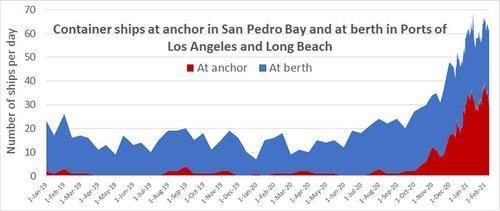
All these supply chain challenges are feeding concerns of inflation could be around the corner. The US producer prices jumped more than forecasted last month, and the March CPI is expected to be released Tuesday.
The four core trade lines worldwide (data provided by Freightos) show prices per 40-foot container began to increase rapidly during the summer of 2000.

It’s unlikely shipping container rates will decline anytime soon as the Biden administration continues to hand out free money to US consumers who turn around and purchase products that are not manufactured in the US.
https://www.zerohedge.com/commodities/shipping-container-rates-expected-remain-elevated-through-year
April 14, 2021
Shipping Container Rates
Shipping Container Rates Expected To Remain Elevated Through Year
by Tyler DurdenWednesday, Apr 14, 2021 – 02:45 AM
Bad news for US importers searching for cheap shipping container rates, that is, rates are as up much as 50% than one year ago. Increasing shipping costs are crimping margins of importers that will ultimately have to be passed onto consumers.
Take, for example, the Asia to North American trade line last week was approximately $2,500 to $3,000 for a 40-foot container, about a 25% to 50% increase than the previous year, George Griffiths, an editor on the global container freight-pricing team at S&P Global Platts, told Bloomberg. Shipping costs create massive headaches for US importers, he said, adding that, the logistical issues they are facing today are extreme.
Hapag-Lloyd CEO Rolf Habben Jansen said container prices are likely to remain elevated through the second half of the year. “I don’t see any signs around the corner that demand is falling off a cliff,” he said.

Meanwhile, Oakland and Long Beach, California ports, both reported record imports for March – on a seasonal basis, usually quiet months for containerized inflows. But no thanks to Jay Powell and Janet Yellen’s historical experiment: unleashing trillions of dollars in helicopter money into consumer pockets has created the largest ever pull forward in history where Americans are using their stimulus checks to purchase goods from Asia.
… and it doesn’t come as any surprise the annual trade deficit for goods came in at an all-time high in January, increasing $3.4 billion to a record $221.1 billion. In another sign of the massive trade imbalance, there is a shortage of shipping containers to bring things into the US.
The congestion is so bad at the US West Coast port that the port’s head told importers to expedite container pickup to alleviate congestion last month. Los Angeles and Long Beach ports are locked in traffic jams of vessels waiting to offload cargo as trillions of dollars in stimulus result in one-sided trade with Asia.
“The container dwell time is much higher than it was pre-pandemic,” Port of Los Angeles Executive Director Gene Seroka told CNBC, referring to the duration a container spends at the port.
Data compiled by Marine Exchange of Southern California shows a massive congestion crisis of moored container ships waiting to unload their cargo.

All these supply chain challenges are feeding concerns of inflation could be around the corner. The US producer prices jumped more than forecasted last month, and the March CPI is expected to be released Tuesday.
The four core trade lines worldwide (data provided by Freightos) show prices per 40-foot container began to increase rapidly during the summer of 2000.

It’s unlikely shipping container rates will decline anytime soon as the Biden administration continues to hand out free money to US consumers who turn around and purchase products that are not manufactured in the US.
https://www.zerohedge.com/commodities/shipping-container-rates-expected-remain-elevated-through-year
April 14, 2021
Everything You Wanted to Know About Rhody’s, or is it Rhodies?

Rhododendron & Azalea News
Where Rhododendrons grow and how they got there.
by Steve Henning
Valley Forge Chapter ARS
| Earth’s Geologic Timeline | |
| Millions of Years Ago | The Event |
| 4,550 | Formation of the Earth |
| 4,527 | Formation of the Moon |
| circa. 4,000 | Heavy Meteor Showers End |
| circa. 3,700 | Earliest microbial life emerges |
| circa. 3,200 | Start of Photosynthesis |
| circa. 2,300 | Oxygen-rich Atmosphere |
| 760 | First creatures: Sea Sponges |
| 750-635 | Snowball Earth (ice covered) |
| 541-485 | Cambrian Explosion: All major animal phyla started appearing in fossil records. |
| circa 470 | Earliest Land Plants |
| circa 380 | First Vertebrate Land Animals |
| 270 | First Ginkgo biloba, a living fossil today |
| 230-66 | Non-Avian Dinosaurs Roamed The Earth |
| circa. 65 | Earliest Ericaceae |
| circa. 55 | Earliest Rhododendrons |
| circa. 25 | Beginning of Asian Monsoons |
| 2 | Earliest Hominins |
For the 1989 ARS Victoria convention, Ted Irving, a retired geophysicist and emeritus scientist with the Geological Survey of Canada, and Richard Hebda, a botanist with the Royal British Columbia Museum, presented an excellent program entitled Concerning The Origin and Distribution of Rhododendrons. It was subsequently published in JARS in 1993. This is a review of their landmark presentation with new material added.
Scientists have combined data from earth sciences, plant science and animal sciences to come up with a fairly detailed theory of when the earth was formed and how it developed.
The theory of plate tectonics and continental drift explains many observations. The original continents Laurasia and Gondwana were together and formed the continent of Pangaea. When they drifted apart Laurasia contained what was to be North America and Eurasia, while Gondwana contained what was to be South America, Africa, India, Antarctica, and Australia. During these processes some areas sank and other areas rose from the oceans. But major land masses survived and the plants on them survived.
Fossil records indicate the Ericaceae emerged about 68 million years ago. Rhododendrons were found in fossils in North America and Eurasia.
Rhododendrons have been in existence for at least 55 million years, but not before 68 million years ago. This is significant because the regions of north Burma, southwest China, and New Guinea that we think of as the centers of rhododendron diversity did not exist 55 million years ago. Since fossils are usually found in lowlands, the lack of numerous fossil records of rhododendrons indicates they were more prevalent in upland habitats much as they are today. Fossil records of rhododendrons were present in North America and Eurasia dated soon after their origin. Alaska and Asia were connected by Beringia, a land mass, in what is now the Bering Strait.
The following sections illustrate several stages in the paleogeographic evolution of rhododendrons proposed by Irving and Hebda. Except for the evergreen azaleas (Tsutsusi) which may always have been fairly restricted, rhododendrons were spread widely across the northern continents during the climatically-mild interval 60 to 40 million years ago. Although widespread and abundant, they were not necessarily represented by many species since they were not strongly diversified.
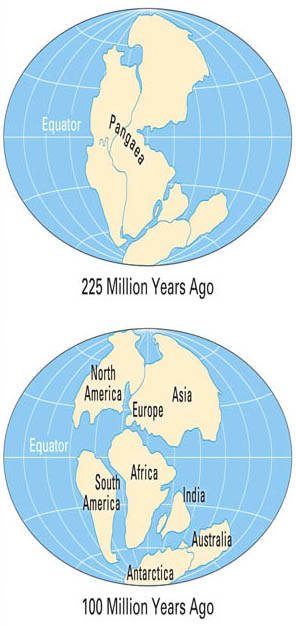
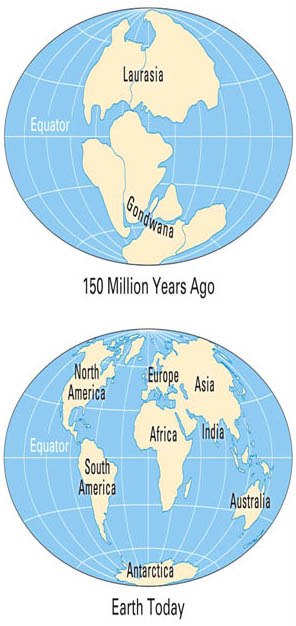
Plate tectonics and continental drift of plates.
55 Million Years Ago
55 million years ago, the Beringia land bridge connected North America with Asia. The high mountains of south Asia hadn’t been formed because the India subcontinent was only approaching Asia. Also, at this time, South America was only approaching North America. Also significant is the fact that Mixed Northern Hardwood Forest connected the northern regions of North America and Asia even extending to Europe. Hence, whether rhododendrons originated in North America, Beringia, or Asia, they could freely spread both directions during the next 15 to 25 million years. Most of the world was tropical except the temperate polar region.
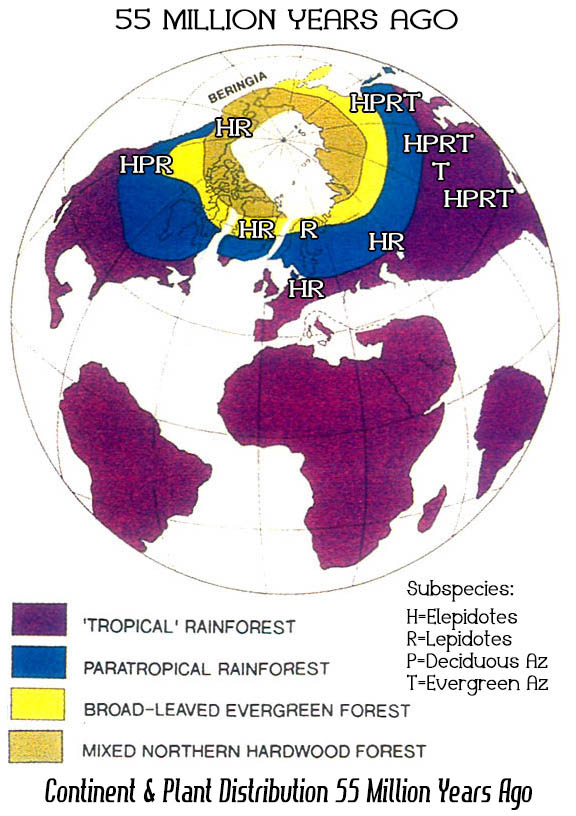
During the early history of rhododendrons 60 to 40 million years ago, North America and Eurasia were close to or north of the positions they occupy today; they were squarely lodged between 30 and 60°N latitude, with large areas north of 60°N. The climate, however, was warmer and more stable, and forests grew at much higher latitudes, because the Earth was then in a non-glacial stage. As a consequence, there apparently were only about four major vegetational zones, compared to about three times that number today. These were respectively, from south to north, “tropical” rain forest (“tropical” placed in quotes because such forest extended well outside the tropics), para-tropical rain forest, broad-leaved evergreen forest, and polar deciduous forest. These ancient forests can only be compared to modern forests in a general way because many modern forest trees had not yet evolved. For example, the dominant coniferous trees were not the spruces, pines and firs of today, but instead were, for the most part, members of the bald cypress family (Taxodiaceae), which includes such trees as the dawn redwoods, the redwoods and the bald cypress, whose range is fragmented now and restricted to small areas.
The polar deciduous forest, which included deciduous hardwoods and conifers such as the dawn redwood, occurred in northern North American and northern Siberia well inside the Arctic Circle. In and just south of the Arctic Circle there was a belt of broad-leaved evergreen forest which included palms, followed by a belt of warm para-tropical rain forest. Both belts probably extended into lower latitudes in upland areas, and both probably provided an environment suitable for rhododendrons. “Tropical” rain forests were the dominant vegetation, which, apparently, covered most low-lying regions in latitudes lower than about 45°. Most areas suitable for rhododendrons were likely to have occurred only in upland regions, but these could have been widespread.
It seems probable on geographic, climatic, and ecological grounds that rhododendrons, during their early history, could have extended more or less continuously from North America to Greenland and Europe, and eastward into China and northeastern Asia. It is probable that they moved freely between North America and Europe across the narrow gulfs of the emerging North Atlantic Ocean as well as across Beringia. The early populations of rhododendrons may not have been composed of very many species.
40 Million Years Ago
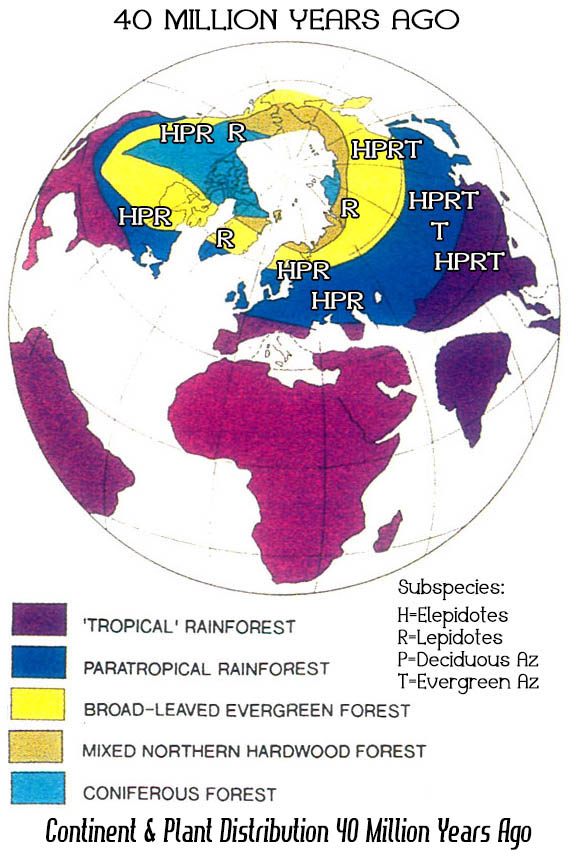
40 million years ago the temperate region was expanding southward. North America was developing its Coniferous Forest and Asia was developing a Broad-Leaved Evergreen Forest. There was still Beringia, the land connection between North America and Asia, and plants could easily migrate within the temperate region.
By 40 million years ago, there were about five global vegetational zones. “Tropical” rain forest occupied a smaller area than before. Polar deciduous forests persisted, and there was a notable development of a northern evergreen coniferous forest composed typically of members of the family Taxodiaceae. The belts of warm para-tropical rain forest and broad-leaved evergreen forest moved southwards and expanded. Except for high mountain regions of SE Asia and it high-island archipelago, both of which had not yet taken shape, the ranges of these two zones embrace the present-day distribution of rhododendrons, including that of the cold-climate R. lapponicum. It appears that in and between the places where rhododendrons are found nowadays, there existed habitats suitable for them. Rhododendrons are still more or less where they always have been.
20 Million Years Ago
About 20 million years ago, the mild climate in middle and high latitudes began to deteriorate and as the North Atlantic opened, suitable environments were restricted and rhododendrons became confined to isolated pockets. At about this time, small founder populations of the subgenera Rhododendron (lepidote) and Hymenanthes (elepidote) colonized what is now high mountain regions of SE Asia as Tibet began to be uplifted, and the deep valleys on its southeastern border were eroded. These founder populations proceeded to speciate, especially during the past few million years.
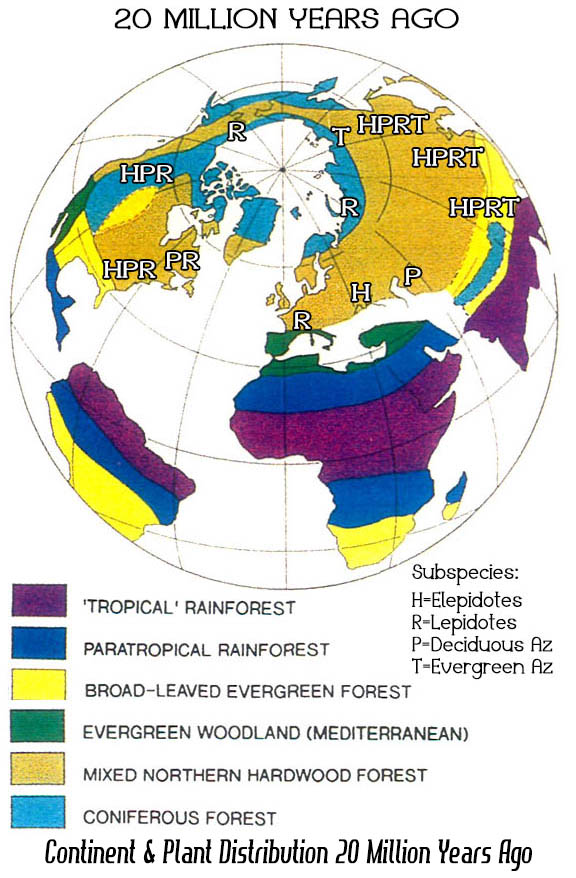
We see that the temperate region extended throughout North America and Eurasia. There was still a land connection between North America and Asia and plants could easily migrate within the temperate region.
By 20 million years ago “tropical” rain forests were further restricted, and cooling in middle and high latitudes had begun. These changes culminated in the glacial periods of the past few million years. Variable continental climates and grasslands began to develop, and there was a further increase in the number of major vegetational zones from about six about 20 million years ago, to about eight today, twice the number present when rhododendrons began. In the north, extensive coniferous forest dominated by the pine family (Pinaceae), came into existence. Its present-day descendant is the boreal forest of northern North America and northern Eurasia. Mixed hardwood and coniferous forest for the first time occupied large areas of Eurasia and North America, but the great broad-leaved evergreen forests were much diminished, becoming restricted as they are today to southeastern China and the southeastern United States. The mixed hardwood and broad-leaved evergreen forests provided the habitats best suited to rhododendrons.
Between 20 million years ago and today, and especially in the last few million years, the climate in middle and high latitudes became much cooler than when rhododendrons first made their appearance. Large areas of desert, semi-desert and grassland developed in central and southwestern North America, across Africa and into Asia. This expansion of arid environments eliminated vast tracts of rhododendron habitat. During the past 2 to 3 million years, vegetational zones fluctuated greatly in response to glacial advances and retreats. This disrupted the climate of lands bordering glaciated areas. There was a broad circumpolar belt of tundra and ice, and “tropical” rain forests shrank to a remnant of their former extent.
High Mountain Region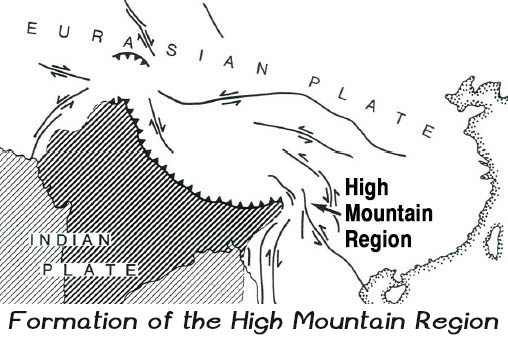
One of the most spectacular events in Earth’s history is the long drawn-out collision of India with Asia which began about 40 million years ago and continues today. This collision set in motion the chain of events which lead to the creation of the high mountain regions of SE Asia and to conditions highly favorable to the development of a rich rhododendron flora.
Prior to 120 million years ago, India formed part of the giant southern supercontinent, Gondwana, which fragmented in piecemeal fashion. In its northward travel. India relentlessly pushed northward, deforming much of southeastern Asia as it went. Immediately north of the zone of contact, the Earth’s crust was doubled in thickness and was lifted up forming the Tibetan Plateau. South of the plateau, debris piled up forming the Himalayas. Together the Tibetan Plateau and the Himalayas form a vast region of high elevation unique on Earth. It is the only region where two continents are colliding with one another today.
The most recent estimates are that the rapid uplift began about 20 million years ago, and that the plateau reached approximately its present elevation about 8 million years ago. The assembly of a landmass as large as Asia and the uplift of the Himalayas and Tibet profoundly affected climate.
Monsoons
About this time the monsoons began. They caused major changes in geography and climate. Monsoons started when India had collided with Asia creating the high mountain region in south Asia. Very low atmospheric pressure centered over Pakistan and stretching northeast to Mongolia developed in summer, drawing wet tropical air from across the equator, and causing heavy rainfall along the southeastern border of Tibet and the Himalayas. As uplift continued, river systems grew, their valleys were deeply etched along large faults in the Earth’s crust that had been developed as India pushed its way into Asia. It is this close fan-shaped network of faults along the southeast border of the Tibetan Plateau that accounts for the geometry and bunching together of the deep valleys. The fault-controlled alignment of valleys provides ready access to rain-bearing prevailing winds ensuring that the slopes of the high mountain regions of SE Asia are well watered. Through time, a landscape evolved which became home to a wide variety of habitats – sub-tropical valley bottoms, temperate slopes, and alpine peaks all very close together.
The monsoons altered the climate creating a rainy season and a dry season. The monsoons altered the geography by creating deep river gorges.
Founder Populations
Speciation occurs more readily in small reproductively isolated populations of plants and animals. In a small population, genetic drift is more likely to cause changes in a population’s characteristics. Such small reproductively isolated populations that undergo rapid diversification are referred to as “founder populations.”
As already explained, it is possible that during the period from about 60 to 40 million years ago, rhododendrons ranged more or less continuously across North America and Eurasia because suitable climates and topographies occurred there over a much wider area than at present. Although rhododendrons may have been widespread and abundant, the uniformity of conditions may not have led to the evolution of many species. As Asia was enlarged by the addition of India, and as the Tibet-Himalaya region was uplifted, new habitats ideal for rhododendrons came into being. Representatives of both lepidote (subgenus Rhododendron) and elepidote (subgenus Hymenanthes) rhododendrons, but not azaleas, expanded into these newly established favorable habitats and became founder populations. The mixed hardwood, coniferous and broad-leaved evergreen forests of eastern Asia 20 million years ago are their most likely habitat.
The Present
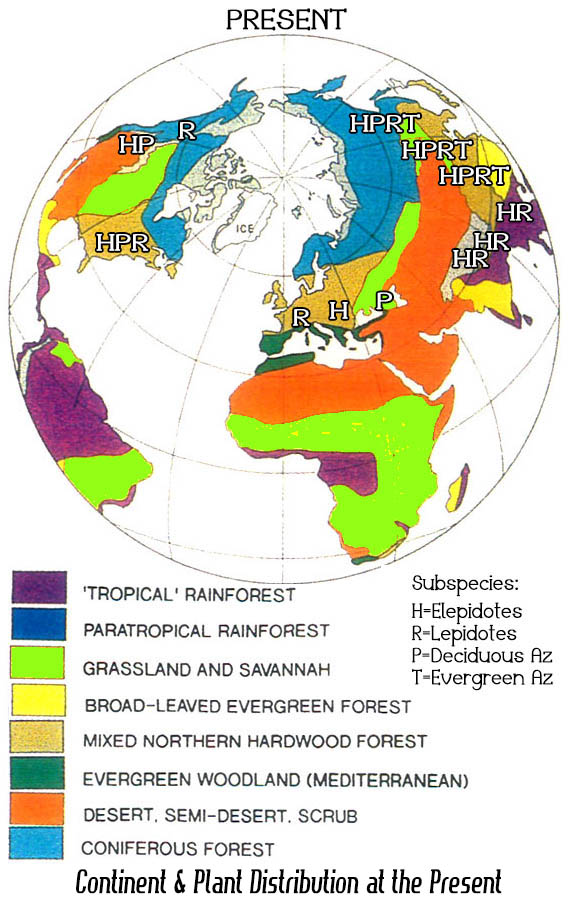
Fast-forward to the present and the connection between North America and Eurasia is gone. The temperate regions are larger and cold polar regions formed at both poles. The far northern climate is no longer hospitable to the more temperate rhododendrons. The region with temperate rhododendrons has now split with parts in western North America, eastern North America, Europe, and southern and Western Asia. The vireyas, an offshoot from the high mountain regions of SE Asia, were a late development which colonized the recently formed high-island archipelago.
Today there are broad belts of desert and semi-deserts in tropical and mid-latitudes which are bordered by broad expanses of tropical and temperate grasslands, something quite unknown 50 million or more years ago when rhododendrons first appeared. The region of broad-leaved evergreens and mixed hardwood and coniferous forest is confined to eastern and southeastern North America, Europe and Asia.
Global Climatic Change
Of course, it is not sufficient to say that because there is a suitably hilly landscape that rhododendrons would actually have grown there. A suitable climate is needed also, and the Earth’s climate is known to have changed drastically since rhododendrons first appeared.
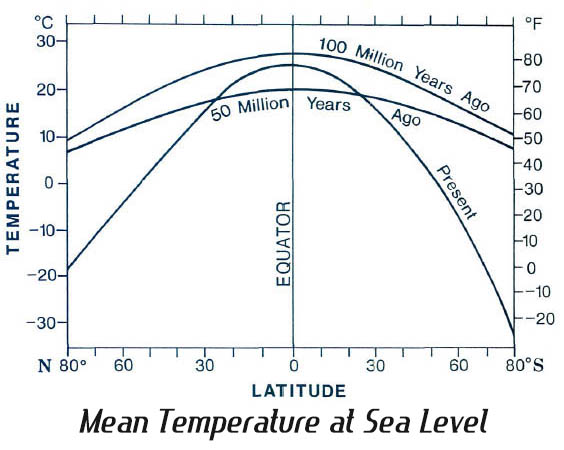
Today there is a year-round ice cap at both poles, the difference in mean surface temperature between pole and equator is over 40°C, and at latitudes above about 55° the mean surface temperature is below freezing. Earth is said to be in a “glacial period”. Earth has been in a glacial period for the past 2 to 3 million years, during which there have been large oscillations roughly every 50,000 years.
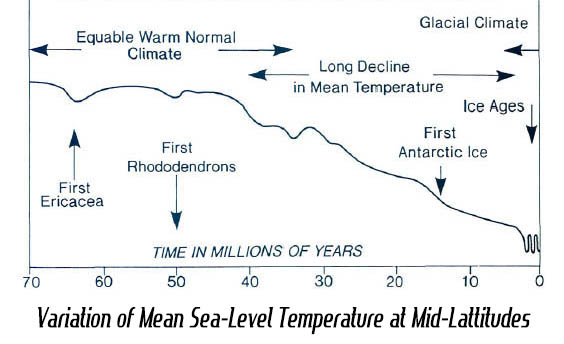
This much simplified graph shows the variation with time of mean surface temperature in middle latitudes. During the early history of ericaceous plants, the Earth had a stable non-glacial climate. This was followed by a long slow decline to about 3 million years ago when the present glacial period commenced, although there is evidence of glacial ice in Antarctica as long ago as 15 million years.
During ice ages glaciers have extended down into intermediate latitudes. Between ice ages, during interglacial periods, glaciers have diminished to about their present extent with glaciers at sea level only near the poles. For the past 10,000 years glaciers have been generally in recession. However, from 100 to 40 million years ago it was much warmer in high latitudes and the pole-to-equator temperature difference was only 10 or 15°C, one-third of that at present. There appears to have been no ice at sea level, and everywhere the mean surface temperature exceeded freezing (0°C). These are the characteristics of a “non-glacial period” and define Earth’s normal climatic regime. Today, climatically speaking, we live in exceptional times.
It is of vital significance for rhododendron evolution that the rapid uplift of the Tibetan Plateau was occurring at a time when global climate was cooling. As Earth entered a glacial period, ice advances and retreats occurred repeatedly every 50 to 100 thousand years.
Speciation in high mountain regions
In the high mountain regions of SE Asia, as an ice age commenced and harsh conditions at high altitudes expanded, species ranges would be displaced downward to lower elevations. Populations in valley bottoms, previously separated by unfavorable condition, could mix with populations from adjacent slopes and valleys, and species could cross after long intervals of separation to generate new hybrids, the potential progenitors of new species. Populations at higher elevations would become separated temporarily from one another by intervening glaciers or unfavorable alpine habitat. These now-separated populations would reproduce in isolation and, over time, diverge from each other by genetic drift following their own evolutionary path. During interglacial intervals, populations at higher elevation could migrate upward over ridges and opportunities for species to mix and separate repeatedly. The large vertical range of valleys and ranges meant that species distributions could be displaced rapidly upward and downward without annihilation, despite major climate shifts, because the actual distances travelled would be short. Consequently, fragmentation and coalescing of rhododendron habitats could have occurred repeatedly as a consequence of glaciation and deglaciation, so producing the present-day diverse flora.
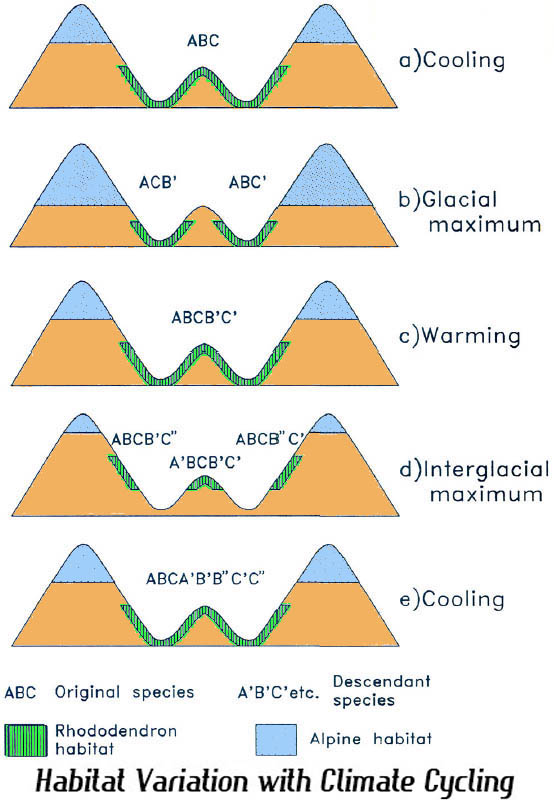
In essence, mountains and deep valleys each act as islands of habitat which repeatedly join and separate as climatic zones and plant populations ascend and descend. These joining-separating cycles occur at about the right interval for them to serve as a forcing process for speciation. A period of 50 to 100 thousand years is generally considered sufficient for a small, physically isolated population to undergo changes great enough to ensure reproductive isolation. These separations and rejoinings would provide repeated opportunities for formerly isolated populations to intermingle.
The end result would be a very large number of closely related species many of which would retain the ability to hybridize. It was precisely this combination of very high mountains situated in tropical latitudes, and cycles of glaciation and deglaciation, that provided the dynamic conditions for the extraordinary speciation of lepidote and elepidote rhododendrons in the high mountain regions of SE Asia. According to this view, most of the speciation has happened in the last 3 million years during the current glacial period.
Lowland areas or mountains of modest size provide fewer opportunities for populations to separate and then rejoin (the hallmark of the above speciation mechanism). They provide no refuge in times of severe climate. In shallow valleys rhododendron populations would be eliminated or greatly reduced as climate deteriorated; as temperatures fell and valleys became occupied by unfavorable habitats or even filled with ice, there would be no possibility of downward migration; as rainfall diminished during warmer interglacial periods, there would be no nearby higher wetter slopes on which to find refuge.
Much of northern North America was covered by ice during major glaciations, whereas to the south relatively dry climate prevailed. There were few suitable habitats nearby, and during ice ages the local rhododendron population must have suffered severely. In the high mountain regions of SE Asia the correct balance appears to have been struck, so that although climatic changes were great, the tropical latitudes and the great depth of the valleys ensured that safe havens were nearby. In such a physical environment, latitudinally well-placed, climate change acts not as an agent of destruction, but as an incentive to diversification. Nowadays, because of its unique elevation, the high mountain regions of SE Asia is isolated botanically from the rest of the Asian land mass of which it is a part. Moreover, the region itself is a vast intricate honeycomb of valleys whose degree of isolation changes as ice ages wax and wane and as continuing uplift and erosion modify their configurations.
Azaleas
Azaleas differ from other rhododendrons in that azaleas only have about one tenth the number of species, and they are absent from the high mountain regions of SE Asia.
Deciduous azaleas occur mainly in southeastern USA and in southeastern Asia and Japan, with scattered representatives in southern Europe, Asia Minor, southwestern Asia, and western North America. This pattern indicates that, as has happened with the subgenera Hymenanthes and Rhododendron, they were more generally distributed over the northern hemisphere, and that their range has since been reduced and fragmented by climatic deterioration and widening of the North Atlantic, which increasingly presented a barrier to dispersal.
Evergreen azaleas are found only in southeastern China and Japan, and it is possible that they have always remained confined to warm temperate broad-leaved evergreen forests. They may never have ventured far beyond their original ecological niches, and their range has, in consequence, shrunk along with that of broad-leaved evergreen forests.
The azaleas are not plants of the high mountain regions of SE Asia although they live close by. Presumably, because of their genetic make-up and historical circumstances, they were unable to take advantage of the dynamic environment of the high mountain regions of SE Asia. Although well positioned to act as founder populations, they failed to do so. In this respect, the paleogeo-graphical evolution of azaleas appears therefore to have been very different from that of other rhododendrons.
Vireyas
The Indo-Malaysian region has an abundance of species from section Vireya of the subgenus Rhododendron. Other representatives of the genus are rare (the evergreen azalea R. subsessile grows in the Philippine Islands). Vireyas are also found, but in much fewer numbers, in the high mountain regions of SE Asia, in the mountain ranges of Indochina and Malaya, and in adjacent areas of southeastern China and Taiwan. In contrast to many other sections, such as the section Ponticum (of the sub-genus Hymenanthes) which has representatives in North America, Europe, and southeastern Asia and a markedly discontinuous distribution, the vireyas are concentrated in one essentially continuous region. This suggests that they have originated comparatively recently, more recently, for example, than the section Ponticum. The terrains in which the majority of vireyas are found today are of recent origin indicating that the abundance and diversity of vireyas is also a recent phenomenon. Many of the mountain ranges of the high-island archipelago, have been created by volcanic activity as the Indian and Pacific Plates pushed the Eurasian Plate up. The highlands of New Guinea, which exceed 4000 meters in relief, began to be uplifted about 4 million years ago. Because the region is near the equator, vegetational zones vary from tropical forest at sea level to alpine grassland with glaciers on the peaks, and they may have fallen as much as 1000 meters during ice ages. Hence, a mechanism for speciation similar to that proposed for the high mountain regions of SE Asia may also be operative here. The founder populations of the section Vireya most likely originated in the high mountain regions of SE Asia within the past few million years. From there they have spread swiftly down the Malay Peninsula into the high-island archipelago where they speciated rapidly. One species has even reached Australia, where it occurs in the tropical rain forest of the Atherton Tableland.
Summary
Rhododendrons originated over 55 million years ago and were more-or-less continuously distributed across North America and Eurasia. The climate was mild and change was slow. Their range became much reduced as a result of worsening of the global climate caused by the formation of high mountains. This worsening began about 25 million years ago, was clearly marked by about 15 million years ago, and became extreme with the onset of the current glacial period about 3 million years ago. Small founder populations of the sub-genera Hymenanthes and Rhododendron (but not azaleas) situated marginal to their main range were able to enter and retain a foothold in the newly developing high mountain regions on the southeastern fringe of the Tibet-Himalayan region. It was from there that the vireyas spread into the mountains of the high-island archipelago. By taking advantage of special newly developing conditions, these small, originally peripheral populations have become now the most numerous and diverse. The place of origin of rhododendrons is not known, but it was not the high mountain regions of SE Asia where nowadays they are most diverse and abundant. That region did not exist then. These conclusions are based on the fossil record of rhododendrons and are based upon the observations of many scientists. They provide reasonable explanations of the present remarkable distribution of rhododendrons and of their differing abilities to cross and recross.
References
- Sleumer, H., Flora Malesiana, series 1, Spermatophyta, Ericacaene, 6,469-914, 1972.
- Molnar, P. and Taponnier, P., Cenozoic Science, 189, 419-426, 1975.
- Savin, S.M., Ann. Rev. Earth Planet. Sci., 5, 319-355, 1977.
- Cullen, J., Notes from the Royal Botanic Gardens Edinburgh, 39, 1-207, 1980.
- Chamberlain, D.F., Notes from the Royal Botanic Gardens Edinburgh, 39, 209-486, 1982.
- Mayr, E., The Growth of Biological Thought. Harvard U. Press, Cambridge, Mass, 1982.
- Wolfe, J.A., Amer. Geophys. Union Geophys. Monogr., 32, 357-375, 1985.
- Hope, G., In Barlow, B.A. (editor) Flora and Fauna of Alpine Australia, Ages and Origins, CSIRO, Melbourne, 131-145, 1986.
- Barron, E.J., Paleoceanography, 2, 729-739, 1987.
- Hill, K.C. and Gleadow, A.O.W., Australian. J. Earth Sci., 36, 515-539, 1989.
- Kron, K.A. and Judd, W.S., Systematic Botany, 15, 57-68, 1990.
- Harrison, T.M., Copeland, P., Kidd, W.S.F. and Yin, A., Science, 255, 1663-1670, 1992.
- Irving, E. and R. Hebda. JARS 47:39, 1993.
- Hall, D.H., JARS 52:1, 1998.
- An ZS, Kutzbach JE and Prell WL et al. Nature 2001; 411: 62–6.
- Denk, T., et.al., J. Linnean Society 149:369-417, 2005.
- KRON, KA. & LUTEYN, J.L. Biol. Skr. 55: 479-500, 2005.
- Quan C, Liu ZH and Utescher T et al. Earth-Sci Rev 2014; 139: 213–30.
- Lu YH and Guo ZT. Sci China Earth Sci; 57: 70–9, 2014.
- Renner SS. J Biogeogr; 43: 1479–87, 2016.
- Spicer RA. Plant Diversity; 39: 233–44, 2017.
- Shrestha N, Su X, Xu X, Wang Z. J Biogeogr. 45:438–447, 2018.
- Chen, Y-S., Natl Sci Rev, 5: 6, 2018.
American Rhododendron Society
P.O. Box 214, Great River, NY 11739
Ph: 631-533-0375 Fax: 866-883-8019 E-Mail: member@arsoffice.org
©1998-2020, ARS, All rights reserved.
http://rhodyman.net/History.html
April 14, 2021
Everything You Wanted to Know About Rhody’s, or is it Rhodies?

Rhododendron & Azalea News
Where Rhododendrons grow and how they got there.
by Steve Henning
Valley Forge Chapter ARS
| Earth’s Geologic Timeline | |
| Millions of Years Ago | The Event |
| 4,550 | Formation of the Earth |
| 4,527 | Formation of the Moon |
| circa. 4,000 | Heavy Meteor Showers End |
| circa. 3,700 | Earliest microbial life emerges |
| circa. 3,200 | Start of Photosynthesis |
| circa. 2,300 | Oxygen-rich Atmosphere |
| 760 | First creatures: Sea Sponges |
| 750-635 | Snowball Earth (ice covered) |
| 541-485 | Cambrian Explosion: All major animal phyla started appearing in fossil records. |
| circa 470 | Earliest Land Plants |
| circa 380 | First Vertebrate Land Animals |
| 270 | First Ginkgo biloba, a living fossil today |
| 230-66 | Non-Avian Dinosaurs Roamed The Earth |
| circa. 65 | Earliest Ericaceae |
| circa. 55 | Earliest Rhododendrons |
| circa. 25 | Beginning of Asian Monsoons |
| 2 | Earliest Hominins |
For the 1989 ARS Victoria convention, Ted Irving, a retired geophysicist and emeritus scientist with the Geological Survey of Canada, and Richard Hebda, a botanist with the Royal British Columbia Museum, presented an excellent program entitled Concerning The Origin and Distribution of Rhododendrons. It was subsequently published in JARS in 1993. This is a review of their landmark presentation with new material added.
Scientists have combined data from earth sciences, plant science and animal sciences to come up with a fairly detailed theory of when the earth was formed and how it developed.
The theory of plate tectonics and continental drift explains many observations. The original continents Laurasia and Gondwana were together and formed the continent of Pangaea. When they drifted apart Laurasia contained what was to be North America and Eurasia, while Gondwana contained what was to be South America, Africa, India, Antarctica, and Australia. During these processes some areas sank and other areas rose from the oceans. But major land masses survived and the plants on them survived.
Fossil records indicate the Ericaceae emerged about 68 million years ago. Rhododendrons were found in fossils in North America and Eurasia.
Rhododendrons have been in existence for at least 55 million years, but not before 68 million years ago. This is significant because the regions of north Burma, southwest China, and New Guinea that we think of as the centers of rhododendron diversity did not exist 55 million years ago. Since fossils are usually found in lowlands, the lack of numerous fossil records of rhododendrons indicates they were more prevalent in upland habitats much as they are today. Fossil records of rhododendrons were present in North America and Eurasia dated soon after their origin. Alaska and Asia were connected by Beringia, a land mass, in what is now the Bering Strait.
The following sections illustrate several stages in the paleogeographic evolution of rhododendrons proposed by Irving and Hebda. Except for the evergreen azaleas (Tsutsusi) which may always have been fairly restricted, rhododendrons were spread widely across the northern continents during the climatically-mild interval 60 to 40 million years ago. Although widespread and abundant, they were not necessarily represented by many species since they were not strongly diversified.


Plate tectonics and continental drift of plates.
55 Million Years Ago
55 million years ago, the Beringia land bridge connected North America with Asia. The high mountains of south Asia hadn’t been formed because the India subcontinent was only approaching Asia. Also, at this time, South America was only approaching North America. Also significant is the fact that Mixed Northern Hardwood Forest connected the northern regions of North America and Asia even extending to Europe. Hence, whether rhododendrons originated in North America, Beringia, or Asia, they could freely spread both directions during the next 15 to 25 million years. Most of the world was tropical except the temperate polar region.

During the early history of rhododendrons 60 to 40 million years ago, North America and Eurasia were close to or north of the positions they occupy today; they were squarely lodged between 30 and 60°N latitude, with large areas north of 60°N. The climate, however, was warmer and more stable, and forests grew at much higher latitudes, because the Earth was then in a non-glacial stage. As a consequence, there apparently were only about four major vegetational zones, compared to about three times that number today. These were respectively, from south to north, “tropical” rain forest (“tropical” placed in quotes because such forest extended well outside the tropics), para-tropical rain forest, broad-leaved evergreen forest, and polar deciduous forest. These ancient forests can only be compared to modern forests in a general way because many modern forest trees had not yet evolved. For example, the dominant coniferous trees were not the spruces, pines and firs of today, but instead were, for the most part, members of the bald cypress family (Taxodiaceae), which includes such trees as the dawn redwoods, the redwoods and the bald cypress, whose range is fragmented now and restricted to small areas.
The polar deciduous forest, which included deciduous hardwoods and conifers such as the dawn redwood, occurred in northern North American and northern Siberia well inside the Arctic Circle. In and just south of the Arctic Circle there was a belt of broad-leaved evergreen forest which included palms, followed by a belt of warm para-tropical rain forest. Both belts probably extended into lower latitudes in upland areas, and both probably provided an environment suitable for rhododendrons. “Tropical” rain forests were the dominant vegetation, which, apparently, covered most low-lying regions in latitudes lower than about 45°. Most areas suitable for rhododendrons were likely to have occurred only in upland regions, but these could have been widespread.
It seems probable on geographic, climatic, and ecological grounds that rhododendrons, during their early history, could have extended more or less continuously from North America to Greenland and Europe, and eastward into China and northeastern Asia. It is probable that they moved freely between North America and Europe across the narrow gulfs of the emerging North Atlantic Ocean as well as across Beringia. The early populations of rhododendrons may not have been composed of very many species.
40 Million Years Ago

40 million years ago the temperate region was expanding southward. North America was developing its Coniferous Forest and Asia was developing a Broad-Leaved Evergreen Forest. There was still Beringia, the land connection between North America and Asia, and plants could easily migrate within the temperate region.
By 40 million years ago, there were about five global vegetational zones. “Tropical” rain forest occupied a smaller area than before. Polar deciduous forests persisted, and there was a notable development of a northern evergreen coniferous forest composed typically of members of the family Taxodiaceae. The belts of warm para-tropical rain forest and broad-leaved evergreen forest moved southwards and expanded. Except for high mountain regions of SE Asia and it high-island archipelago, both of which had not yet taken shape, the ranges of these two zones embrace the present-day distribution of rhododendrons, including that of the cold-climate R. lapponicum. It appears that in and between the places where rhododendrons are found nowadays, there existed habitats suitable for them. Rhododendrons are still more or less where they always have been.
20 Million Years Ago
About 20 million years ago, the mild climate in middle and high latitudes began to deteriorate and as the North Atlantic opened, suitable environments were restricted and rhododendrons became confined to isolated pockets. At about this time, small founder populations of the subgenera Rhododendron (lepidote) and Hymenanthes (elepidote) colonized what is now high mountain regions of SE Asia as Tibet began to be uplifted, and the deep valleys on its southeastern border were eroded. These founder populations proceeded to speciate, especially during the past few million years.

We see that the temperate region extended throughout North America and Eurasia. There was still a land connection between North America and Asia and plants could easily migrate within the temperate region.
By 20 million years ago “tropical” rain forests were further restricted, and cooling in middle and high latitudes had begun. These changes culminated in the glacial periods of the past few million years. Variable continental climates and grasslands began to develop, and there was a further increase in the number of major vegetational zones from about six about 20 million years ago, to about eight today, twice the number present when rhododendrons began. In the north, extensive coniferous forest dominated by the pine family (Pinaceae), came into existence. Its present-day descendant is the boreal forest of northern North America and northern Eurasia. Mixed hardwood and coniferous forest for the first time occupied large areas of Eurasia and North America, but the great broad-leaved evergreen forests were much diminished, becoming restricted as they are today to southeastern China and the southeastern United States. The mixed hardwood and broad-leaved evergreen forests provided the habitats best suited to rhododendrons.
Between 20 million years ago and today, and especially in the last few million years, the climate in middle and high latitudes became much cooler than when rhododendrons first made their appearance. Large areas of desert, semi-desert and grassland developed in central and southwestern North America, across Africa and into Asia. This expansion of arid environments eliminated vast tracts of rhododendron habitat. During the past 2 to 3 million years, vegetational zones fluctuated greatly in response to glacial advances and retreats. This disrupted the climate of lands bordering glaciated areas. There was a broad circumpolar belt of tundra and ice, and “tropical” rain forests shrank to a remnant of their former extent.
High Mountain Region
One of the most spectacular events in Earth’s history is the long drawn-out collision of India with Asia which began about 40 million years ago and continues today. This collision set in motion the chain of events which lead to the creation of the high mountain regions of SE Asia and to conditions highly favorable to the development of a rich rhododendron flora.
Prior to 120 million years ago, India formed part of the giant southern supercontinent, Gondwana, which fragmented in piecemeal fashion. In its northward travel. India relentlessly pushed northward, deforming much of southeastern Asia as it went. Immediately north of the zone of contact, the Earth’s crust was doubled in thickness and was lifted up forming the Tibetan Plateau. South of the plateau, debris piled up forming the Himalayas. Together the Tibetan Plateau and the Himalayas form a vast region of high elevation unique on Earth. It is the only region where two continents are colliding with one another today.
The most recent estimates are that the rapid uplift began about 20 million years ago, and that the plateau reached approximately its present elevation about 8 million years ago. The assembly of a landmass as large as Asia and the uplift of the Himalayas and Tibet profoundly affected climate.
Monsoons
About this time the monsoons began. They caused major changes in geography and climate. Monsoons started when India had collided with Asia creating the high mountain region in south Asia. Very low atmospheric pressure centered over Pakistan and stretching northeast to Mongolia developed in summer, drawing wet tropical air from across the equator, and causing heavy rainfall along the southeastern border of Tibet and the Himalayas. As uplift continued, river systems grew, their valleys were deeply etched along large faults in the Earth’s crust that had been developed as India pushed its way into Asia. It is this close fan-shaped network of faults along the southeast border of the Tibetan Plateau that accounts for the geometry and bunching together of the deep valleys. The fault-controlled alignment of valleys provides ready access to rain-bearing prevailing winds ensuring that the slopes of the high mountain regions of SE Asia are well watered. Through time, a landscape evolved which became home to a wide variety of habitats – sub-tropical valley bottoms, temperate slopes, and alpine peaks all very close together.
The monsoons altered the climate creating a rainy season and a dry season. The monsoons altered the geography by creating deep river gorges.
Founder Populations
Speciation occurs more readily in small reproductively isolated populations of plants and animals. In a small population, genetic drift is more likely to cause changes in a population’s characteristics. Such small reproductively isolated populations that undergo rapid diversification are referred to as “founder populations.”
As already explained, it is possible that during the period from about 60 to 40 million years ago, rhododendrons ranged more or less continuously across North America and Eurasia because suitable climates and topographies occurred there over a much wider area than at present. Although rhododendrons may have been widespread and abundant, the uniformity of conditions may not have led to the evolution of many species. As Asia was enlarged by the addition of India, and as the Tibet-Himalaya region was uplifted, new habitats ideal for rhododendrons came into being. Representatives of both lepidote (subgenus Rhododendron) and elepidote (subgenus Hymenanthes) rhododendrons, but not azaleas, expanded into these newly established favorable habitats and became founder populations. The mixed hardwood, coniferous and broad-leaved evergreen forests of eastern Asia 20 million years ago are their most likely habitat.
The Present

Fast-forward to the present and the connection between North America and Eurasia is gone. The temperate regions are larger and cold polar regions formed at both poles. The far northern climate is no longer hospitable to the more temperate rhododendrons. The region with temperate rhododendrons has now split with parts in western North America, eastern North America, Europe, and southern and Western Asia. The vireyas, an offshoot from the high mountain regions of SE Asia, were a late development which colonized the recently formed high-island archipelago.
Today there are broad belts of desert and semi-deserts in tropical and mid-latitudes which are bordered by broad expanses of tropical and temperate grasslands, something quite unknown 50 million or more years ago when rhododendrons first appeared. The region of broad-leaved evergreens and mixed hardwood and coniferous forest is confined to eastern and southeastern North America, Europe and Asia.
Global Climatic Change
Of course, it is not sufficient to say that because there is a suitably hilly landscape that rhododendrons would actually have grown there. A suitable climate is needed also, and the Earth’s climate is known to have changed drastically since rhododendrons first appeared.

Today there is a year-round ice cap at both poles, the difference in mean surface temperature between pole and equator is over 40°C, and at latitudes above about 55° the mean surface temperature is below freezing. Earth is said to be in a “glacial period”. Earth has been in a glacial period for the past 2 to 3 million years, during which there have been large oscillations roughly every 50,000 years.

This much simplified graph shows the variation with time of mean surface temperature in middle latitudes. During the early history of ericaceous plants, the Earth had a stable non-glacial climate. This was followed by a long slow decline to about 3 million years ago when the present glacial period commenced, although there is evidence of glacial ice in Antarctica as long ago as 15 million years.
During ice ages glaciers have extended down into intermediate latitudes. Between ice ages, during interglacial periods, glaciers have diminished to about their present extent with glaciers at sea level only near the poles. For the past 10,000 years glaciers have been generally in recession. However, from 100 to 40 million years ago it was much warmer in high latitudes and the pole-to-equator temperature difference was only 10 or 15°C, one-third of that at present. There appears to have been no ice at sea level, and everywhere the mean surface temperature exceeded freezing (0°C). These are the characteristics of a “non-glacial period” and define Earth’s normal climatic regime. Today, climatically speaking, we live in exceptional times.
It is of vital significance for rhododendron evolution that the rapid uplift of the Tibetan Plateau was occurring at a time when global climate was cooling. As Earth entered a glacial period, ice advances and retreats occurred repeatedly every 50 to 100 thousand years.
Speciation in high mountain regions
In the high mountain regions of SE Asia, as an ice age commenced and harsh conditions at high altitudes expanded, species ranges would be displaced downward to lower elevations. Populations in valley bottoms, previously separated by unfavorable condition, could mix with populations from adjacent slopes and valleys, and species could cross after long intervals of separation to generate new hybrids, the potential progenitors of new species. Populations at higher elevations would become separated temporarily from one another by intervening glaciers or unfavorable alpine habitat. These now-separated populations would reproduce in isolation and, over time, diverge from each other by genetic drift following their own evolutionary path. During interglacial intervals, populations at higher elevation could migrate upward over ridges and opportunities for species to mix and separate repeatedly. The large vertical range of valleys and ranges meant that species distributions could be displaced rapidly upward and downward without annihilation, despite major climate shifts, because the actual distances travelled would be short. Consequently, fragmentation and coalescing of rhododendron habitats could have occurred repeatedly as a consequence of glaciation and deglaciation, so producing the present-day diverse flora.

In essence, mountains and deep valleys each act as islands of habitat which repeatedly join and separate as climatic zones and plant populations ascend and descend. These joining-separating cycles occur at about the right interval for them to serve as a forcing process for speciation. A period of 50 to 100 thousand years is generally considered sufficient for a small, physically isolated population to undergo changes great enough to ensure reproductive isolation. These separations and rejoinings would provide repeated opportunities for formerly isolated populations to intermingle.
The end result would be a very large number of closely related species many of which would retain the ability to hybridize. It was precisely this combination of very high mountains situated in tropical latitudes, and cycles of glaciation and deglaciation, that provided the dynamic conditions for the extraordinary speciation of lepidote and elepidote rhododendrons in the high mountain regions of SE Asia. According to this view, most of the speciation has happened in the last 3 million years during the current glacial period.
Lowland areas or mountains of modest size provide fewer opportunities for populations to separate and then rejoin (the hallmark of the above speciation mechanism). They provide no refuge in times of severe climate. In shallow valleys rhododendron populations would be eliminated or greatly reduced as climate deteriorated; as temperatures fell and valleys became occupied by unfavorable habitats or even filled with ice, there would be no possibility of downward migration; as rainfall diminished during warmer interglacial periods, there would be no nearby higher wetter slopes on which to find refuge.
Much of northern North America was covered by ice during major glaciations, whereas to the south relatively dry climate prevailed. There were few suitable habitats nearby, and during ice ages the local rhododendron population must have suffered severely. In the high mountain regions of SE Asia the correct balance appears to have been struck, so that although climatic changes were great, the tropical latitudes and the great depth of the valleys ensured that safe havens were nearby. In such a physical environment, latitudinally well-placed, climate change acts not as an agent of destruction, but as an incentive to diversification. Nowadays, because of its unique elevation, the high mountain regions of SE Asia is isolated botanically from the rest of the Asian land mass of which it is a part. Moreover, the region itself is a vast intricate honeycomb of valleys whose degree of isolation changes as ice ages wax and wane and as continuing uplift and erosion modify their configurations.
Azaleas
Azaleas differ from other rhododendrons in that azaleas only have about one tenth the number of species, and they are absent from the high mountain regions of SE Asia.
Deciduous azaleas occur mainly in southeastern USA and in southeastern Asia and Japan, with scattered representatives in southern Europe, Asia Minor, southwestern Asia, and western North America. This pattern indicates that, as has happened with the subgenera Hymenanthes and Rhododendron, they were more generally distributed over the northern hemisphere, and that their range has since been reduced and fragmented by climatic deterioration and widening of the North Atlantic, which increasingly presented a barrier to dispersal.
Evergreen azaleas are found only in southeastern China and Japan, and it is possible that they have always remained confined to warm temperate broad-leaved evergreen forests. They may never have ventured far beyond their original ecological niches, and their range has, in consequence, shrunk along with that of broad-leaved evergreen forests.
The azaleas are not plants of the high mountain regions of SE Asia although they live close by. Presumably, because of their genetic make-up and historical circumstances, they were unable to take advantage of the dynamic environment of the high mountain regions of SE Asia. Although well positioned to act as founder populations, they failed to do so. In this respect, the paleogeo-graphical evolution of azaleas appears therefore to have been very different from that of other rhododendrons.
Vireyas
The Indo-Malaysian region has an abundance of species from section Vireya of the subgenus Rhododendron. Other representatives of the genus are rare (the evergreen azalea R. subsessile grows in the Philippine Islands). Vireyas are also found, but in much fewer numbers, in the high mountain regions of SE Asia, in the mountain ranges of Indochina and Malaya, and in adjacent areas of southeastern China and Taiwan. In contrast to many other sections, such as the section Ponticum (of the sub-genus Hymenanthes) which has representatives in North America, Europe, and southeastern Asia and a markedly discontinuous distribution, the vireyas are concentrated in one essentially continuous region. This suggests that they have originated comparatively recently, more recently, for example, than the section Ponticum. The terrains in which the majority of vireyas are found today are of recent origin indicating that the abundance and diversity of vireyas is also a recent phenomenon. Many of the mountain ranges of the high-island archipelago, have been created by volcanic activity as the Indian and Pacific Plates pushed the Eurasian Plate up. The highlands of New Guinea, which exceed 4000 meters in relief, began to be uplifted about 4 million years ago. Because the region is near the equator, vegetational zones vary from tropical forest at sea level to alpine grassland with glaciers on the peaks, and they may have fallen as much as 1000 meters during ice ages. Hence, a mechanism for speciation similar to that proposed for the high mountain regions of SE Asia may also be operative here. The founder populations of the section Vireya most likely originated in the high mountain regions of SE Asia within the past few million years. From there they have spread swiftly down the Malay Peninsula into the high-island archipelago where they speciated rapidly. One species has even reached Australia, where it occurs in the tropical rain forest of the Atherton Tableland.
Summary
Rhododendrons originated over 55 million years ago and were more-or-less continuously distributed across North America and Eurasia. The climate was mild and change was slow. Their range became much reduced as a result of worsening of the global climate caused by the formation of high mountains. This worsening began about 25 million years ago, was clearly marked by about 15 million years ago, and became extreme with the onset of the current glacial period about 3 million years ago. Small founder populations of the sub-genera Hymenanthes and Rhododendron (but not azaleas) situated marginal to their main range were able to enter and retain a foothold in the newly developing high mountain regions on the southeastern fringe of the Tibet-Himalayan region. It was from there that the vireyas spread into the mountains of the high-island archipelago. By taking advantage of special newly developing conditions, these small, originally peripheral populations have become now the most numerous and diverse. The place of origin of rhododendrons is not known, but it was not the high mountain regions of SE Asia where nowadays they are most diverse and abundant. That region did not exist then. These conclusions are based on the fossil record of rhododendrons and are based upon the observations of many scientists. They provide reasonable explanations of the present remarkable distribution of rhododendrons and of their differing abilities to cross and recross.
References
- Sleumer, H., Flora Malesiana, series 1, Spermatophyta, Ericacaene, 6,469-914, 1972.
- Molnar, P. and Taponnier, P., Cenozoic Science, 189, 419-426, 1975.
- Savin, S.M., Ann. Rev. Earth Planet. Sci., 5, 319-355, 1977.
- Cullen, J., Notes from the Royal Botanic Gardens Edinburgh, 39, 1-207, 1980.
- Chamberlain, D.F., Notes from the Royal Botanic Gardens Edinburgh, 39, 209-486, 1982.
- Mayr, E., The Growth of Biological Thought. Harvard U. Press, Cambridge, Mass, 1982.
- Wolfe, J.A., Amer. Geophys. Union Geophys. Monogr., 32, 357-375, 1985.
- Hope, G., In Barlow, B.A. (editor) Flora and Fauna of Alpine Australia, Ages and Origins, CSIRO, Melbourne, 131-145, 1986.
- Barron, E.J., Paleoceanography, 2, 729-739, 1987.
- Hill, K.C. and Gleadow, A.O.W., Australian. J. Earth Sci., 36, 515-539, 1989.
- Kron, K.A. and Judd, W.S., Systematic Botany, 15, 57-68, 1990.
- Harrison, T.M., Copeland, P., Kidd, W.S.F. and Yin, A., Science, 255, 1663-1670, 1992.
- Irving, E. and R. Hebda. JARS 47:39, 1993.
- Hall, D.H., JARS 52:1, 1998.
- An ZS, Kutzbach JE and Prell WL et al. Nature 2001; 411: 62–6.
- Denk, T., et.al., J. Linnean Society 149:369-417, 2005.
- KRON, KA. & LUTEYN, J.L. Biol. Skr. 55: 479-500, 2005.
- Quan C, Liu ZH and Utescher T et al. Earth-Sci Rev 2014; 139: 213–30.
- Lu YH and Guo ZT. Sci China Earth Sci; 57: 70–9, 2014.
- Renner SS. J Biogeogr; 43: 1479–87, 2016.
- Spicer RA. Plant Diversity; 39: 233–44, 2017.
- Shrestha N, Su X, Xu X, Wang Z. J Biogeogr. 45:438–447, 2018.
- Chen, Y-S., Natl Sci Rev, 5: 6, 2018.
American Rhododendron Society
P.O. Box 214, Great River, NY 11739
Ph: 631-533-0375 Fax: 866-883-8019 E-Mail: member@arsoffice.org
©1998-2020, ARS, All rights reserved.
http://rhodyman.net/History.html
